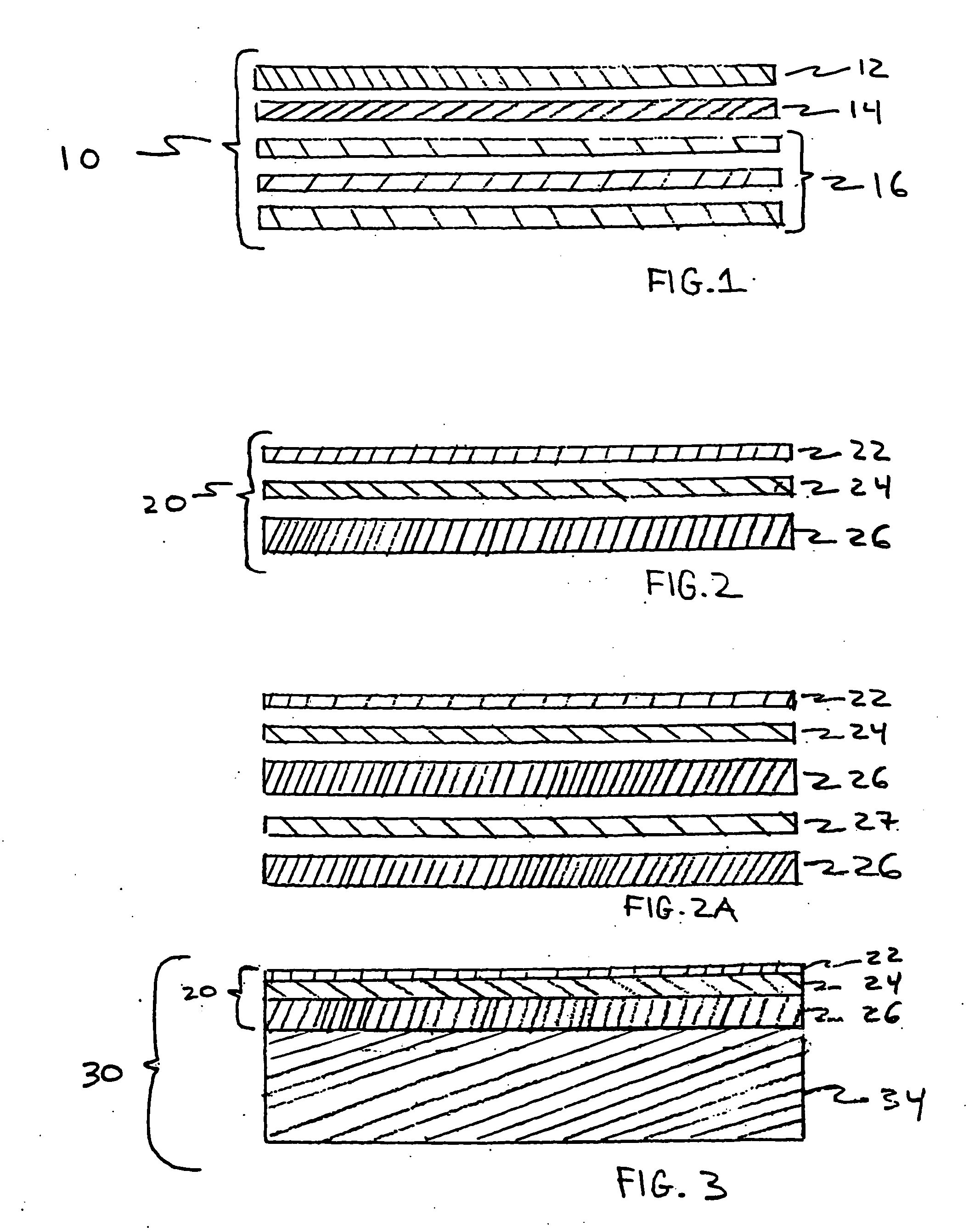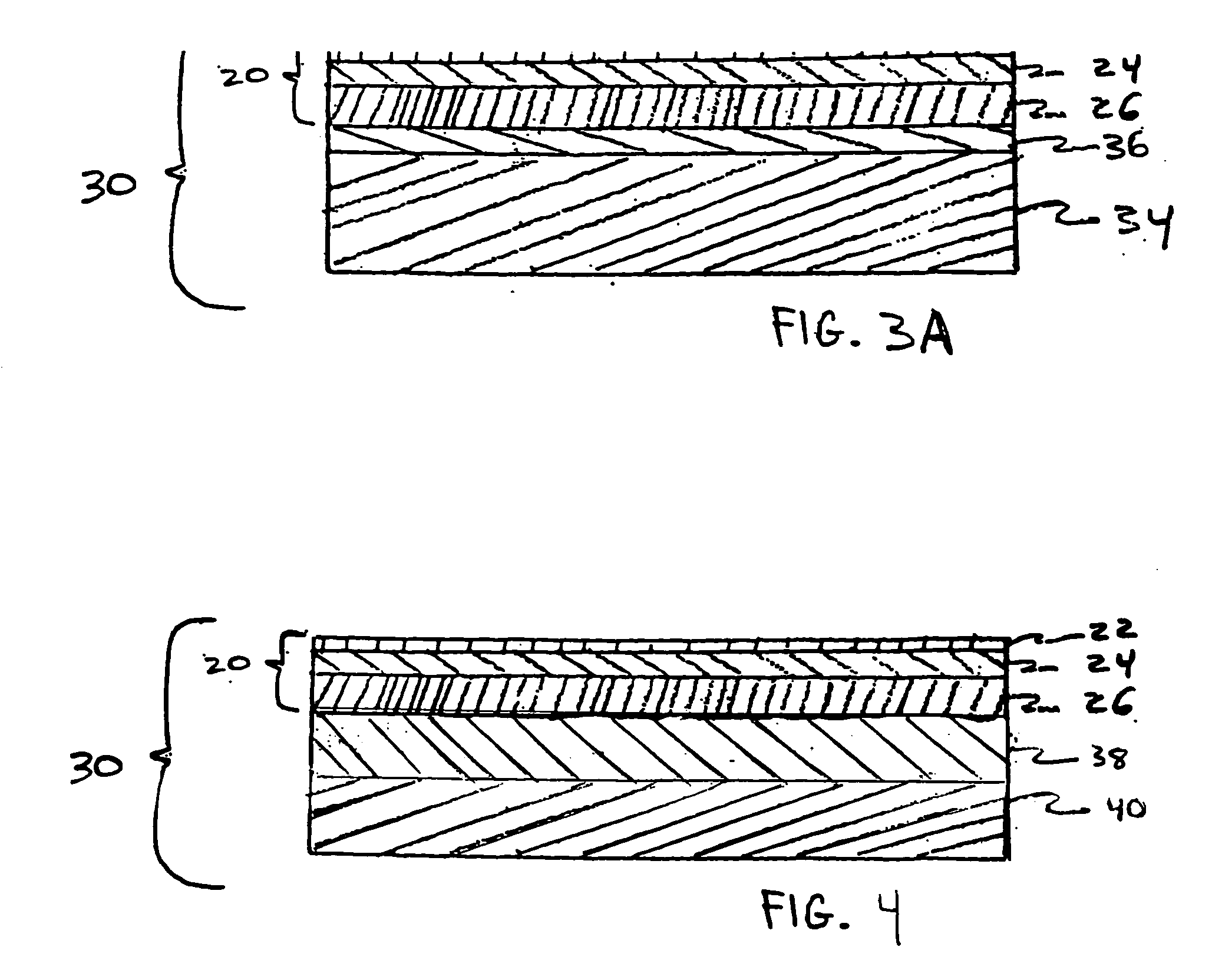Decorative laminate assembly and method of producing same
a technology of decorative laminates and laminates, applied in the field of decorative laminate assemblies, can solve the problems of reducing the aesthetically attractiveness of vinyl tiles or linoleum-like, limiting the application of existing decorative laminates, and reducing the application of adhesives to the substrate (and/or top layer), so as to achieve enhanced wear resistance qualities, avoid material, labor and equipment costs of adhesive application to the substrate, and avoid the effect of adhesive application
- Summary
- Abstract
- Description
- Claims
- Application Information
AI Technical Summary
Benefits of technology
Problems solved by technology
Method used
Image
Examples
example 1
Bonding with Adhesive
[0061] A melamine-formaldehyde resin was prepared by normal procedures familiar to those versed in the art, with a 1.4 / 1 formaldehyde / melamine mole ratio, and co-reacted with 7% dicyandiamide based on melamine and formaldehyde solids, in a 50% aqueous solution at 92° C. The following resin blend was then prepared with this plasticized melamine resin, with all parts being parts by weight: [0062] 69.0 parts melamine resin [0063] 4.6 parts polyethylene glycol 600 MW (Union Carbide Carbowax 600) [0064] 5.7 parts Cymel 385 partially methylated melamine resin (CyTec Industries) [0065] 20.5 parts water [0066] 0.1 parts MoldWiz INT-1E-11 S release agent (Axel Plastics) [0067] 0.1 Iparts Cycat 4040 p-toluene sulfonic acid catalyst solution (CyTec Industries) [0068] 100.0 parts Total
[0069] Those versed in the art will appreciate that other polyfunctional amino and aldehydic compounds can be used to prepare the base resin, and other thermosetting polymers, such as polyes...
example 2
Direct Bonding without Adhesive
[0078] The Mead abrasive loaded high wear overlay treated with the preferred plasticized melamine resin blend detailed and used in the previous Example 1, corresponding to that used for Sample 4 of Table III, was also used for all the decorative laminate assemblies prepared in this present Example 2. The print papers were either treated with the neat dicyandiamide modified melamine (MF) resin, corresponding to Sample 3 of the previous Example 1, or a proprietary melamine-formaldehyde / urea-formaldehyde (MF / UF) resin blend supplied by Duynea Overlays, Inc. of Tacoma, Wash. The Eastman Chemical Company 0.020 inch thick Eastar PETG Copolyester 6763 was used exclusively for all the decorative laminate assemblies of the present example, wherein the plasticized melamine resin treated overlay, treated print deco paper, and PETG core laminate portion were bonded to a filled PVC composite, or alternatively a cement fiberboard, substrate in a single pressing ope...
PUM
| Property | Measurement | Unit |
|---|---|---|
| thick | aaaaa | aaaaa |
| pressure | aaaaa | aaaaa |
| pressure | aaaaa | aaaaa |
Abstract
Description
Claims
Application Information
 Login to View More
Login to View More - R&D
- Intellectual Property
- Life Sciences
- Materials
- Tech Scout
- Unparalleled Data Quality
- Higher Quality Content
- 60% Fewer Hallucinations
Browse by: Latest US Patents, China's latest patents, Technical Efficacy Thesaurus, Application Domain, Technology Topic, Popular Technical Reports.
© 2025 PatSnap. All rights reserved.Legal|Privacy policy|Modern Slavery Act Transparency Statement|Sitemap|About US| Contact US: help@patsnap.com



